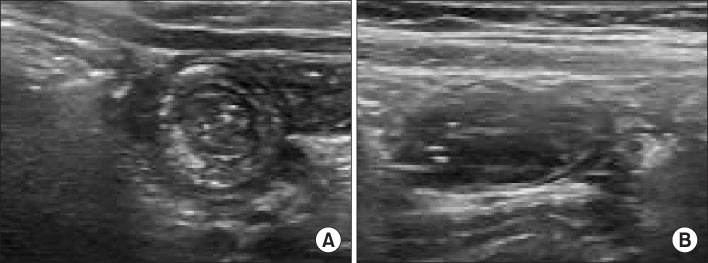1. DiFiore JW. Intussusception. Semin Pediatr Surg. 1999; 8:214–220.

2. Lehnert T, Sorge I, Till H, Rolle U. Intussusception in children-clinical presentation, diagnosis and management. Int J Colorectal Dis. 2009; 24:1187–1192.

3. Ko SF, Tiao MM, Hsieh CS, Huang FC, Huang CC, Ng SH, et al. Pediatric small bowel intussusception disease: feasibility of screening for surgery with early computed tomographic evaluation. Surgery. 2010; 147:521–528.

4. Saxena AK, Seebacher U, Bernhardt C, Hollwarth ME. Small bowel intussusceptions: issues and controversies related to pneumatic reduction and surgical approach. Acta Paediatr. 2007; 96:1651–1654.

5. Hur NJ, Ryu MH, Lee DJ, Kwon JH. A clinical observation on children with transient small bowel intussusception. Korean J Pediatr Gastroenterol Nutr. 2000; 3:160–168.

6. Kornecki A, Daneman A, Navarro O, Connolly B, Manson D, Alton DJ. Spontaneous reduction of intussusception: clinical spectrum, management and outcome. Pediatr Radiol. 2000; 30:58–63.

7. Parikh M, Samujh R, Kanojia R, Sodhi KS. Does all small bowel intussuseption need exploration? Afr J Paediatr Surg. 2010; 7:30–32.
8. Ko SF, Lee TY, Ng SH, Wan YL, Chen MC, Tiao MM, et al. Small bowel intussusception in symptomatic pediatric patients: experiences with 19 surgically proven cases. World J Surg. 2002; 26:438–443.
9. Strouse PJ, DiPietro MA, Saez F. Transient small-bowel intussusception in children on CT. Pediatr Radiol. 2003; 33:316–320.

10. Tiao MM, Wan YL, Ng SH, Ko SF, Lee TY, Chen MC, et al. Sonographic features of small-bowel intussusception in pediatric patients. Acad Emerg Med. 2001; 8:368–373.

11. del-Pozo G, Albillos JC, Tejedor D, Calero R, Rasero M, de-la-Calle U, et al. Intussusception in children: current concepts in diagnosis and enema reduction. Radiographics. 1999; 19:299–319.

12. Bisset GS 3rd, Kirks DR. Intussusception in infants and children: diagnosis and therapy. Radiology. 1988; 168:141–145.

13. Lim HK, Bae SH, Lee KH, Seo GS, Yoon GS. Assessment of reducibility of ileocolic intussusception in children: usefulness of color Doppler sonography. Radiology. 1994; 191:781–785.

14. Lee HC, Yeh HJ, Leu YJ. Intussusception: the sonographic diagnosis and its clinical value. J Pediatr Gastroenterol Nutr. 1989; 8:343–347.
15. Verschelden P, Filiatrault D, Garel L, Grignon A, Perreault G, Boisvert J, et al. Intussusception in children: reliability of US in diagnosis--a prospective study. Radiology. 1992; 184:741–744.

16. Pracros JP, Tran-Minh VA, Morin de Finfe CH, Deffrenne-Pracros P, Louis D, Basset T. Acute intestinal intussusception in children. Contribution of ultrasonography (145 cases). Ann Radiol (Paris). 1987; 30:525–530.
17. Doi O, Aoyama K, Hutson JM. Twenty-one cases of small bowel intussusception: the pathophysiology of idiopathic intussusception and the concept of benign small bowel intussusception. Pediatr Surg Int. 2004; 20:140–143.

18. Kim JH. US features of transient small bowel intussusception in pediatric patients. Korean J Radiol. 2004; 5:178–184.

19. Lee HS, Chung JY, Koo JW, Kim SW, Kim SH. Clinical characteristics of intussusception in children: comparison between small bowel and large bowel type. Korean J Gastroenterol. 2006; 47:37–43.
20. Lim HT, Park JH, Choi HJ, Kim JS, Shin HK, Gu CH. Clinical approach of ultrasonography in the diagnosis of intussusception in infant and children. J Korean Pediatr Soc. 1994; 37:649–654.




 PDF
PDF ePub
ePub Citation
Citation Print
Print




 XML Download
XML Download